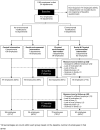Effectiveness of a worksite social & physical environment intervention on need for recovery, physical activity and relaxation; results of a randomized controlled trial
- PMID: 25542039
- PMCID: PMC4277283
- DOI: 10.1371/journal.pone.0114860
Effectiveness of a worksite social & physical environment intervention on need for recovery, physical activity and relaxation; results of a randomized controlled trial
Abstract
Objective: To investigate the effectiveness of a worksite social and physical environment intervention on need for recovery (i.e., early symptoms of work-related mental and physical fatigue), physical activity and relaxation. Also, the effectiveness of the separate interventions was investigated.
Methods: In this 2 × 2 factorial design study, 412 office employees from a financial service provider participated. Participants were allocated to the combined social and physical intervention, to the social intervention only, to the physical intervention only or to the control group. The primary outcome measure was need for recovery. Secondary outcomes were work-related stress (i.e., exhaustion, detachment and relaxation), small breaks, physical activity (i.e., stair climbing, active commuting, sport activities, light/moderate/vigorous physical activity) and sedentary behavior. Outcomes were measured by questionnaires at baseline, 6 and 12 months follow-up. Multilevel analyses were performed to investigate the effects of the three interventions.
Results: In all intervention groups, a non-significant reduction was found in need for recovery. In the combined intervention (n = 92), exhaustion and vigorous physical activities decreased significantly, and small breaks at work and active commuting increased significantly compared to the control group. The social intervention (n = 118) showed a significant reduction in exhaustion, sedentary behavior at work and a significant increase in small breaks at work and leisure activities. In the physical intervention (n = 96), stair climbing at work and active commuting significantly increased, and sedentary behavior at work decreased significantly compared to the control group.
Conclusion: None of the interventions was effective in improving the need for recovery. It is recommended to implement the social and physical intervention among a population with higher baseline values of need for recovery. Furthermore, the intervention itself could be improved by increasing the intensity of the intervention (for example weekly GMI-sessions), providing physical activity opportunities and exercise schemes, and by more drastic environment interventions (restructuring entire department floor).
Trial registration: Nederlands Trial Register NTR2553.
Conflict of interest statement
Figures
References
-
- EU-OSHA. European agency for safety and health at work. European Survey on new and emerging risk. Available: https://osha.europa.eu/nl/topics/stress. Accessed 2014 Nov 14.
-
- Jansen NWH, Kant I, Van den Brandt PA (2002) Need for recovery in working population: description and associations with fatigue and psychological distress. Int J Behav Med 4:322–40. - PubMed
-
- (2005) The Netherlands working conditions survey (nationale enquête arbeidsomstandigheden, NEA).
-
- Meijman T, Mulder G (2012) Psychological aspects of workload. In: Drenth P, Thierry H, editors. Handbook of work and organizational psychology. Hove, England: Psychology. pp.5–33.
-
- Sonnentag S, Zijlstra F (2006) Job characteristics and off-job activities as predictors of need for recovery, well-being and fatigue. J Appl Psychol 91:330–50. - PubMed
Publication types
MeSH terms
Associated data
LinkOut - more resources
Full Text Sources
Other Literature Sources
Medical



